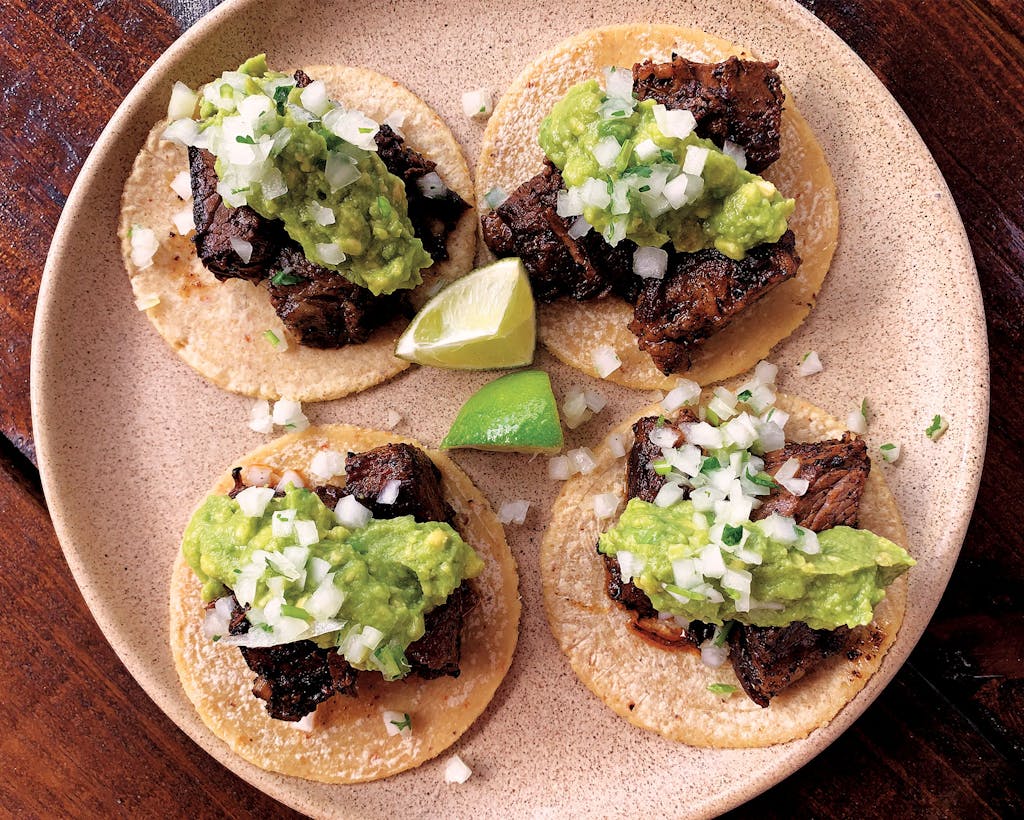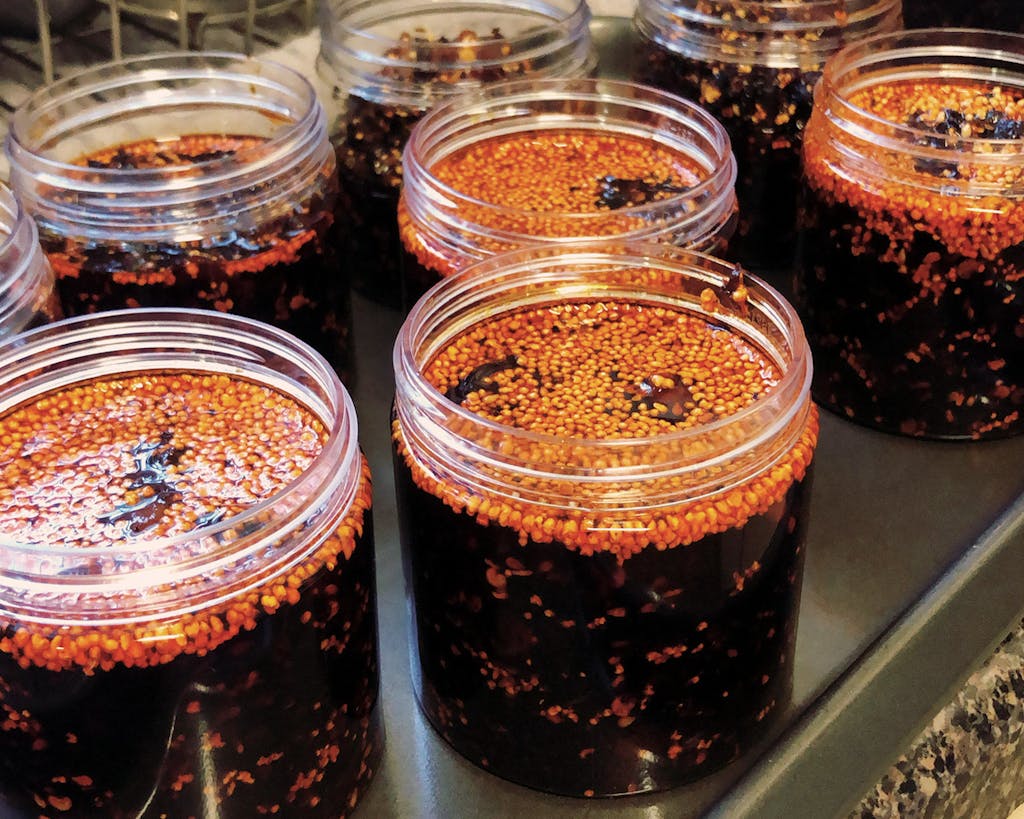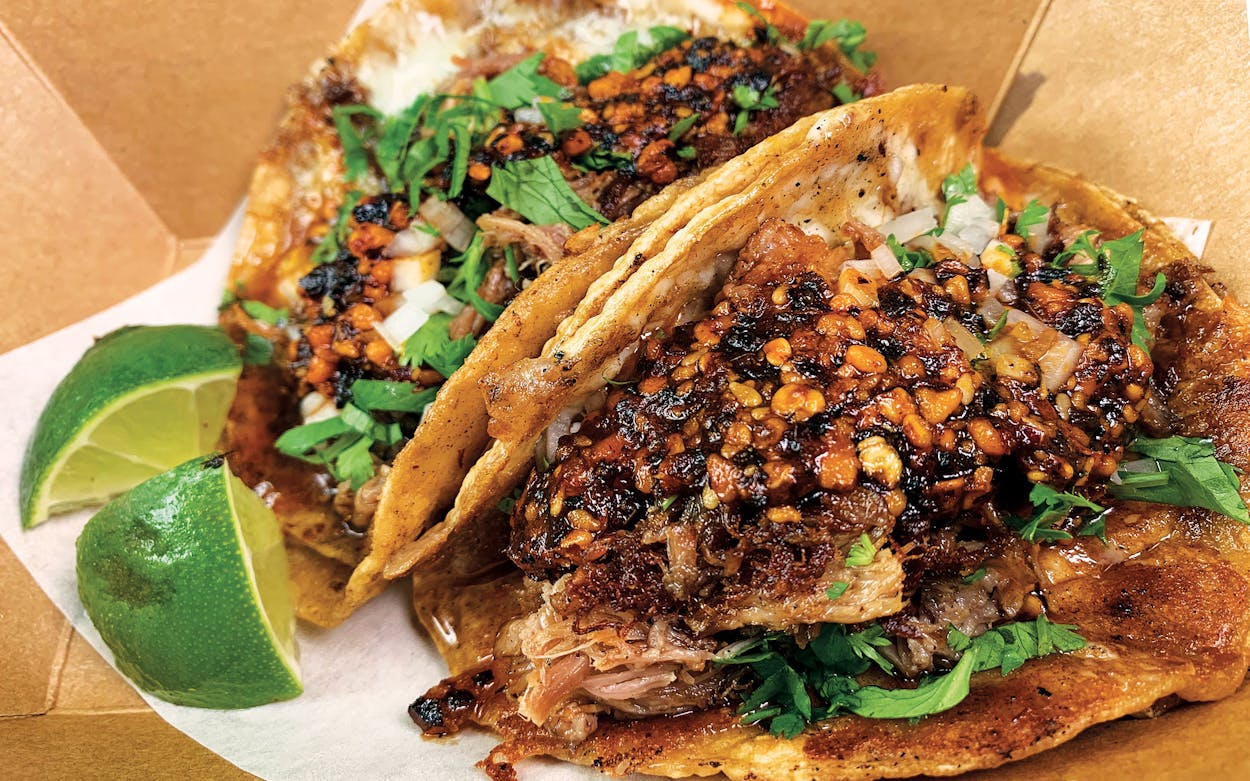Salsa macha is hot. Within the last five years, this fiery, oil-based salsa has grown from an obscure condiment to an in-demand item at Texas taquerias and restaurants. In Austin, Suerte executive chef Fermín Núñez calls his variation “black magic oil.” Nuñez’s version, which envelops the restaurant’s exquisite suadero tacos, includes fermented black soybeans and black sesame seeds mixed with garlic and toasted morita chiles.
It’s a recipe that Núñez has been playing with since the early aughts. Over the years, he experimented with different names for the salsa, looking for a moniker that would draw customers rather than scare them off. On one occasion, he made salsa at home for his partner at the time. She described it as amazing, saying she’d never tasted anything like the silky, umami-layered dish. According to Núñez, when he told her it was salsa macha, she called it “weird.” Was it related to matcha tea, she wondered? “After she said that, it kind of ruined the name for me,” the chef says. He eventually settled on the alluring moniker of black magic oil, which has been on the menu at Suerte since its opening in March 2018. The salsa is beloved by Suerte’s diners, and the trend is spreading fast. Restaurants, trucks, and start-up condiment companies across the state now sell salsa macha. The New York Times recently dubbed it “the most valuable condiment of 2020.”
Salsa macha has its roots in Orizaba, a city in the Mexican state of Veracruz. Its name is taken from the feminine for “macho,” and its base recipe is ripe for tweaking. The only requirements are chiles, seeds, nuts, and oil. That last ingredient gives it a paste-like consistency resembling that of Asian chile oil sauce. This isn’t as surprising a connection as you might initially think. For centuries after Mesoamerica’s conquest, Veracruz, founded by Spanish conquistador Hernán Cortés in 1519, was a major port of trade welcoming commodities from the East. No one knows for sure, but it’s possible both Asian chile oil and salsa macha were products of innovation spurred by cross-continental trade. A similar culinary cross-pollination took place in Acapulco, three hundred miles southwest of Orizaba, where Spanish ships brought Japanese influences that still echo in Mexican cuisine today.
Salsa macha likely has indigenous roots as well, however. The Totonac people of Veracruz have long prepared a similar salsa, albeit without the oil base. It’s a pulverized combination of dried chile, sesame seeds, and salt—ingredients still commonly used in most versions. Salsa macha doesn’t require refrigeration, since the oil acts as a preservative. Notably, it doesn’t include tomatoes or tomatillos.

Ultimately, salsa macha, which is spicy more often than not, is ripe for personalization. Other oil-based salsas exist, but they are rare. Iliana de la Vega, executive chef and co-owner of Oaxacan-leaning El Naranjo, in Austin, describes the oil-based salsas in her mother’s native Oaxaca as local specialties: “Those are regional and few people know of them.” De la Vega and her husband, Ernesto Torrealba, put salsa macha on the El Naranjo menu in 2013. A year later, as a result of increasing customer requests, the couple began selling the salsa—a nutty and fruity seven-chile blend that ends with a joyful, addictive wallop of spice—in jars. After a slow-burning rise, salsa macha is a full-on fiery trend. “Now everyone has a version,” de la Vega says.
In North Austin, Margarito Pérez makes a batch of salsa macha weekly for his taco truck, Paprika ATX. The spice is mild, but it might leave a tickle of heat on the inside of your nose. It’s become a customer favorite since Pérez opened his truck in late 2019. Born in Matamoros, Mexico, he first tasted the salsa during his youth in Indiana, where his mother dated a man from Veracruz. “I remember that salsa catching my eye because it was so vibrantly red and oily,” he recalls. “I was absolutely blown away.”
Pérez’s recipe incorporates grapeseed oil, peanuts, and skin-on garlic cloves. The chiles are the same varieties he uses for much of his truck’s menu: guajillo, árbol, cascabel, and ancho. I especially like the salsa macha on Paprika ATX’s sous-vide carnitas. The pork’s sweetness pairs well with the garnish’s balanced fruitiness and earthiness.
Pérez predicts that salsa macha will become even more popular. “It’s the avocado toast of salsa,” he declares. “And it’s only a matter of a time before someone puts salsa macha on avocado toast.” Part of the allure is that the name sounds exotic. It’s unlike any salsa folks have had, and has a secret-menu quality to it.
At Taconeta, in El Paso, a mahogany-hued, Asian-inspired version tops the house suadero taco. Concocted from a blend of thin, zippy chiles japonés, black sesame seeds, garlic, and fermented black beans, the salsa is named for Goku, the hero of the multimedia Japanese Dragon Ball franchise, which has a deep Latino following. The salsa has a woodsy, moderately spicy flavor and a sense of playfulness befitting its namesake. Taconeta is experimenting with other versions as well. A garam masala–inspired salsa macha with raisins and pepitas tops a sweet potato taco, while another salsa macha is applied to an avocado tostada, which is pretty darn close to toast.
In Houston last summer, Felix Emilio established Salsa Macha Felix, a line of six jarred salsa machas, after losing his job as a chef because of the pandemic. “My salsa macha is based on a recipe I have been making for many years, perfecting it over time,” says Emilio, whose family partially hails from Veracruz. “I took that and all that I knew about the fine-dining techniques that I have learned over the years, and I just put it into the recipe.”
Emilio’s flagship salsa contains a five-chile blend, cinnamon, cloves, pepitas, peanuts, and sunflower seeds, and a few secret ingredients he won’t share. Salsa Macha Felix also offers weekly specials using apricots, blueberries, cranberries, mezcal, and more. Jars are available online and via Instagram. Emilio says he appreciates the dish’s adaptability. “There’s really no rule book,” he says. “You can take it anywhere you want it.” This versatility and openness will set all of Texas ablaze with salsa macha.

Where to Buy Salsa Macha in Texas
Austin
El Naranjo
2717 S. Lamar Boulevard, Suite 1085
512-520-5750
Nixta Taqueria
2512 E. Twelfth
512-551-3855
Paprika ATX
6519 N. Lamar Boulevard
512-716-5873
Dallas
Resident Taqueria
9661 Audelia Road, Suite 112
972-685-5280
El Paso
Taconeta
311 Montana Avenue, Suite A-1
915-303-8038
Elemi
313 N. Kansas
915-532-2090
Houston
Cochinita & Co.
713-309-6410
Henderson & Kane General Store
715 Henderson
281-974-3557
Salsa Macha Felix
713-210-9841








